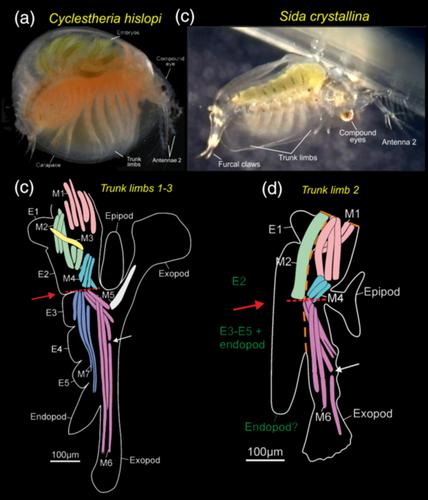当前位置:
X-MOL 学术
›
J. Morphol.
›
论文详情
Our official English website, www.x-mol.net, welcomes your
feedback! (Note: you will need to create a separate account there.)
Transitions in functional morphology from “large branchiopods” to Cladocera: Video and confocal microscopic studies of Cyclestheria hislopi (Cyclestherida) and Sida crystallina (Cladocera: Ctenopoda)
Journal of Morphology ( IF 1.5 ) Pub Date : 2020-08-20 , DOI: 10.1002/jmor.21244 Zandra M S Sigvardt 1, 2 , Katrine Worsaae 2 , Sukonthip Savatenalinton 3 , Alexandra Kerbl 2 , Jørgen Olesen 1
Journal of Morphology ( IF 1.5 ) Pub Date : 2020-08-20 , DOI: 10.1002/jmor.21244 Zandra M S Sigvardt 1, 2 , Katrine Worsaae 2 , Sukonthip Savatenalinton 3 , Alexandra Kerbl 2 , Jørgen Olesen 1
Affiliation

|
Great diversity is found in morphology and functionality of arthropod appendages, both along the body axis of individual animals and between different life‐cycle stages. Despite many branchiopod crustaceans being well known for displaying a relatively simple arrangement of many serially post‐maxillary appendages (trunk limbs), this taxon also shows an often unappreciated large variation in appendage morphology. Diplostracan branchiopods exhibit generally a division of labor into locomotory antennae and feeding/filtratory post‐maxillary appendages (trunk limbs). We here study the functionality and morphology of the swimming antennae and feeding appendages in clam shrimps and cladocerans and analyze the findings in an evolutionary context (e.g., possible progenetic origin of Cladocera). We focus on Cyclestheria hislopi (Cyclestherida), sister species to Cladocera and exhibiting many “large” branchiopod characters (e.g., many serially similar appendages), and Sida crystallina (Cladocera, Ctenopoda), which likely exhibits plesiomorphic cladoceran traits (e.g., six pairs of serially similar appendages). We combine (semi‐)high‐speed recordings of behavior with confocal laser scanning microscopy analyses of musculature to infer functionality and homologies of locomotory and filtratory appendages in the two groups. Our morphological study shows that the musculature in all trunk limbs (irrespective of limb size) of both C. hislopi and S. crystallina comprises overall similar muscle groups in largely corresponding arrangements. Some differences between C. hislopi and S. crystallina, such as fewer trunk limbs and antennal segments in the latter, may reflect a progenetic origin of Cladocera. Other differences seem related to the appearance of a specialized type of swimming and feeding in Cladocera, where the anterior locomotory system (antennae) and the posterior feeding system (trunk limbs) have become fully separated functionally from each other. This separation is likely one explanation for the omnipresence of cladocerans, which have conquered both freshwater and marine free water masses and a number of other habitats.
中文翻译:

从“大鳃足类动物”到枝角类动物的功能形态转变:Cyclestheria hislopi (Cyclestherida) 和 Sida crystallina (Cladocera: Ctenopoda) 的视频和共聚焦显微镜研究
节肢动物附属物的形态和功能存在很大差异,无论是沿着个体动物的身体轴线还是不同生命周期阶段之间。尽管许多鳃足类甲壳类动物以显示许多连续上颌后附属物(躯干肢体)的相对简单排列而闻名,但该分类群也显示出通常未被重视的附属物形态学的巨大变化。Diplostracan branchiopods 通常表现出对运动触角和摄食/过滤性上颌后附属物(躯干肢体)的分工。我们在这里研究了蛤虾和枝角类动物的游泳触角和摄食附属物的功能和形态,并在进化背景下分析了这些发现(例如,枝角类动物的可能后代起源)。我们专注于Cyclestheria hislopi (Cyclestherida),枝角类的姊妹种并表现出许多“大”的枝足类特征(例如,许多连续相似的附属物),以及可能表现出多形性枝角类特征(例如,六对连续相似的附属物)的水晶丝藻(Cladocera,Ctenopoda)。我们将(半)高速行为记录与肌肉组织的共聚焦激光扫描显微镜分析相结合,以推断两组中运动和过滤附属物的功能和同源性。我们的形态学研究表明,C. hislopi 和 S.crystallina 的所有躯干四肢(无论四肢大小)的肌肉组织都包含整体相似的肌肉群,排列大致对应。C. hislopi 和 S.crystallina 之间的一些差异,例如后者的躯干肢和触角节较少,可能反映了枝角类动物的遗传起源。其他差异似乎与枝角目中一种特殊类型的游泳和进食有关,其中前运动系统(触角)和后进食系统(躯干肢体)在功能上已经完全分离。这种分离可能是枝角类无处不在的一种解释,枝角类动物已经征服了淡水和海洋自由水团以及许多其他栖息地。
更新日期:2020-08-20
中文翻译:

从“大鳃足类动物”到枝角类动物的功能形态转变:Cyclestheria hislopi (Cyclestherida) 和 Sida crystallina (Cladocera: Ctenopoda) 的视频和共聚焦显微镜研究
节肢动物附属物的形态和功能存在很大差异,无论是沿着个体动物的身体轴线还是不同生命周期阶段之间。尽管许多鳃足类甲壳类动物以显示许多连续上颌后附属物(躯干肢体)的相对简单排列而闻名,但该分类群也显示出通常未被重视的附属物形态学的巨大变化。Diplostracan branchiopods 通常表现出对运动触角和摄食/过滤性上颌后附属物(躯干肢体)的分工。我们在这里研究了蛤虾和枝角类动物的游泳触角和摄食附属物的功能和形态,并在进化背景下分析了这些发现(例如,枝角类动物的可能后代起源)。我们专注于Cyclestheria hislopi (Cyclestherida),枝角类的姊妹种并表现出许多“大”的枝足类特征(例如,许多连续相似的附属物),以及可能表现出多形性枝角类特征(例如,六对连续相似的附属物)的水晶丝藻(Cladocera,Ctenopoda)。我们将(半)高速行为记录与肌肉组织的共聚焦激光扫描显微镜分析相结合,以推断两组中运动和过滤附属物的功能和同源性。我们的形态学研究表明,C. hislopi 和 S.crystallina 的所有躯干四肢(无论四肢大小)的肌肉组织都包含整体相似的肌肉群,排列大致对应。C. hislopi 和 S.crystallina 之间的一些差异,例如后者的躯干肢和触角节较少,可能反映了枝角类动物的遗传起源。其他差异似乎与枝角目中一种特殊类型的游泳和进食有关,其中前运动系统(触角)和后进食系统(躯干肢体)在功能上已经完全分离。这种分离可能是枝角类无处不在的一种解释,枝角类动物已经征服了淡水和海洋自由水团以及许多其他栖息地。











































 京公网安备 11010802027423号
京公网安备 11010802027423号